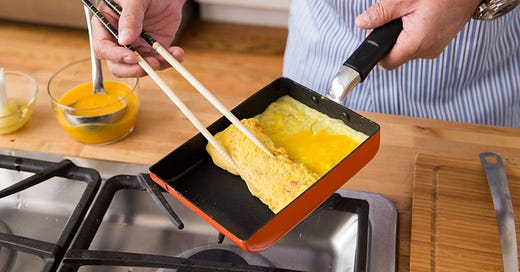Experience the Delight of Tamagoyaki
Today, we dive into the culinary genius of Chef Masaharu Morimoto with a spotlight on his unique take on the traditional Japanese omelet, tamagoyaki, from his cookbook Mastering the Art of Japanese Home Cooking. This slightly sweet and custardy marvel is not your everyday Western omelet—one bite and you'll be hooked!
The Art of Tamagoyaki
Tamagoyaki, literally meaning "grilled egg," is a Japanese dish consisting of rolled omelet layers that are both sweet and savory. The name comes from "tamago" (egg) and "yaki" (grilled or cooked). This delightful dish is prepared by combining beaten eggs with ingredients like sugar, soy sauce, and sometimes mirin or sake, depending on the desired sweetness and flavor.
Cooking tamagoyaki involves a special rectangular pan called a tamagoyaki pan or makiyakinabe. You pour a thin layer of the egg mixture into the pan, let it set slightly, and then roll it up. This process is repeated, adding layers until a thick roll forms, which is then sliced into bite-sized pieces. It’s a visually impressive dish with a delicate texture and balanced flavor, often served as a breakfast dish, in bento boxes, or as a side dish in sushi restaurants.
A Bite of History
Tamagoyaki has its roots in the Edo period of Japan, although the origins of rolled or layered egg dishes in Japanese cuisine might be traced back even further. It evolved from older Japanese egg dishes like "usuyaki tamago" (thin egg sheets), used in sushi and other dishes. Over time, tamagoyaki became a staple in Japanese cuisine, appreciated for its convenience, nutritional value, and versatility.
Chef Morimoto’s Masterful Touch
Chef Masaharu Morimoto, renowned for his seamless integration of Western and Japanese ingredients, brings a unique flair to traditional dishes like tamagoyaki. Morimoto first competed on the Japanese television show Iron Chef in 1998 and became one of the stars of Iron Chef America in 1999, showcasing his flawless technique and creativity with unique ingredients.
His cookbook, Mastering The Art of Japanese Home Cooking, offers a treasure trove of recipes, including tamagoyaki. With step-by-step instructions, even beginners can attempt this dish and impress their friends with their culinary skills.
Recipe: Tamagoyaki
Special Equipment:
One approximately 7 by 5-inch tamagoyaki pan (highly recommended)
¼ cup plus 2 tablespoons Dashi (dried fish and kelp stock) or Kombu Dashi (kelp stock)
1 teaspoon usukuchi (Japanese light-colored soy sauce)
1 tablespoon granulated sugar
4 large eggs
Vegetable oil
Instructions:
Combine the dashi, soy sauce, and sugar in a large bowl and stir until the sugar has dissolved.
Add the eggs to the bowl and beat to combine well.
Set a medium-mesh sieve over a measuring cup with a spout and pour in the egg mixture. Strain the mixture, stirring to get most of the liquid through, leaving just about a tablespoon of the thick whites in the sieve.
Set the tamagoyaki pan or an 8-inch nonstick skillet over medium heat. Let it get hot for a few minutes.
Pour a tablespoon or two of the oil into a small bowl. Dip a folded paper towel into the oil and briefly rub the surface and sides of the pan. Keep the paper towel nearby.
Pour just enough of the egg mixture (about 3 tablespoons) into the pan to cover the surface, and immediately swirl the egg mixture so it covers the bottom in a thin layer.
Let the egg cook, without stirring, just until it sets, about 20 seconds.
Take the pan off the heat, tilt the handle down, and use a nonmetal spatula to gently fold the egg forward in half onto itself.
Set the pan back on the heat, rub the empty space at the back of the pan with oil, then slide the cooked egg into the empty space. Rub the now-empty space in the front of the pan with oil.
Pour about 3 tablespoons more of the egg mixture into the empty space, tilting the pan and slightly lifting the cooked egg so the liquidy egg runs underneath it. Cook until the raw egg has just set, 30 to 45 seconds.
Repeat the process until you’ve used all of the egg mixture. If the omelet is not golden brown in spots on both sides, cook over medium heat for a few minutes on each side.
Transfer the omelet to a cutting board, let it cool slightly, and slice it crosswise into ¾-inch-thick slices. Serve warm.
A Fun Culinary Adventure
Preparing tamagoyaki might take a little time and practice to get right, but even your first attempt will impress your friends. The delicate layers of eggy goodness make this dish a true culinary adventure, perfect for any meal.
Stay tuned for more culinary adventures, lifestyle tips, and stories that inspire. Happy cooking!
Vodka Sauce with Prosciutto Recipe
Vodka sauce is a creamy tomato-based sauce that is commonly served with pasta dishes. Its origin is somewhat disputed, but it is believed to have originated in the United States, specifically in the Italian-American communities in the Northeast. The exact origins of the sauce are unclear, but it is generally believed that vodka sauce was first made in th…







